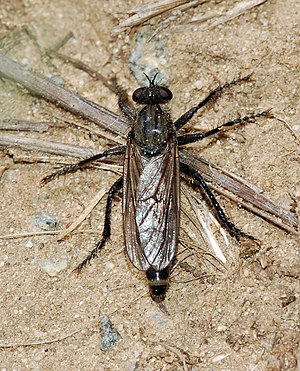Common gray weight
| Common gray weight | ||||||||||||
|---|---|---|---|---|---|---|---|---|---|---|---|---|

Common gray weight, female |
||||||||||||
| Systematics | ||||||||||||
|
||||||||||||
| Scientific name | ||||||||||||
| Lasiopogon cinctus | ||||||||||||
| ( Fabricius , 1781) |
The common gray wight ( Lasiopogon cinctus ), sometimes also called the common jackdaw fly, is a two-winged bird from the family of predatory flies (Asilidae).
features
The common gray-weight reaches a body length of 7 to 12 millimeters and is therefore one of the smaller species of predatory fly in Central Europe. The basic color of the body is dark gray to black, light gray cross bars in the apical area of the abdominal segments contrast them. The legs are also darkly colored, metacoxal no appendages are formed. The thorax is darkly haired, the scutum has a medial stripe. In the facial area, which is also hairy, a clear facial hump is formed, the area of which extends far beyond the mouth area.
Occurrence
The range of the species extends from Bulgaria and the Balkans over Italy and large parts of the European mainland north to the Arctic Ocean and east to eastern Russia. Within Germany, most of the known deposits are in the north German lowlands, in the Berlin area and in Saxony.
Way of life
The flight time of the common gray weight in Central Europe begins around mid-April and lasts until the beginning of July. In the north German lowlands, forests, which only let some sunlight through to the ground in spring, as well as open areas such as grasslands and gardens are populated. Soil type and moisture content do not seem to have any influence on the choice of location. In southern Germany, on the other hand, the species seems to be much more tied to dry and warm, often sandy, small habitats. It is therefore conceivable that the north and south German populations could be two different species. A sudden increase in the number of individuals at the beginning of the flight time with a subsequent phase without any further increase in population suggests that the adults hatch almost simultaneously from the pupae. In May the number of flies then drops significantly. The common gray weight is one of the predatory fly species that prefer to stay near the ground. The animals look for sunny, vegetation-free areas here, with pieces of branches, leaves or pine needles serving as a hide. In order to take advantage of the often limited warmth in early spring, the body is usually directed towards the sun. In colder weather phases, the animals seek protection in the vegetation or under dead wood. Passing insects are hunted from the hide, with other flies, preferably 4-6 mm in size, being captured. Mating usually takes place in the afternoon or evening. To do this, an approaching male grabs a sitting female, turns it on its back and grabs the female ovipositor with its holding forceps . The mating then takes place in opposite body positions. The eggs are laid in sandy places in the ground, where the larvae then develop.
Danger
The species is widespread in Germany and the available data do not reveal any negative population development. It is therefore considered safe in Germany.
Taxonomy
The species was described by Fabricius in 1781 as Asilus cinctus and placed by Loew in the newly established genus Lasiopogon in 1847. Worldwide the genus comprises around 120 species (as of 2002) of which only Lasiopogon cinctus occurs in Germany. The species belongs to the subfamily Stichopogoninae, which is represented in Germany by three other species from the genus Stichopogon.
Web links
- On the faunistics of predatory flies in Germany
- Lasiopogon cinctus in the identification atlas of predatory flies in Germany
Individual evidence
- ↑ RA Cannings, J. Kahanpää: Lasiopogon septentrionalis, a robber fly (Diptera: Asilidae) new to the European fauna. In: Entomol. Fennica. 24, 2013, pp. 113-116.
- ↑ a b F. Geller-Grimm: Identification key of the Stichopogoninae. In: Photo atlas and identification key for predatory flies in Germany (Diptera: Asilidae). 2003.
- ^ F. Geller-Grimm: Lasiopogon cinctus (Fabricius, 1781). In: Photo atlas and identification key for predatory flies in Germany (Diptera: Asilidae). 2003.
- ^ Lasiopogon cinctus. In: T. Pape, P. Beuk (Eds.): Fauna Europaea. Diptera, version 2.6.2.
- ↑ Flight times of predatory flies in Germany. Table at Asilidae.de, accessed on March 30, 2015
- ↑ a b D. Wolff: Lasiopogon cinctus (FABRICIUS, 1781) - Common gray weight. In: Atlas of the predatory flies of Germany. Version: 4.18.0, 2014, accessed March 30, 2015.
- ↑ F. Geller-Grimm: Autecological studies on robber flies (Diptera: Asilidae) on inland dunes of the Upper Rhine Valley Trench. Thesis. TH-Darmstadt, 1995. (online as PDF)
- ^ FH Loew : About the European robber flies (Diptera, Asilica). In: Linnaea entomologica . Volume 2, 1847, pp. 384-568, 585-591, (online) .
- ^ RA Cannings: The systematics of Lasiopogon (Diptera: Asilidae). Royal British Columbia Museum, Victoria, Canada 2002.
